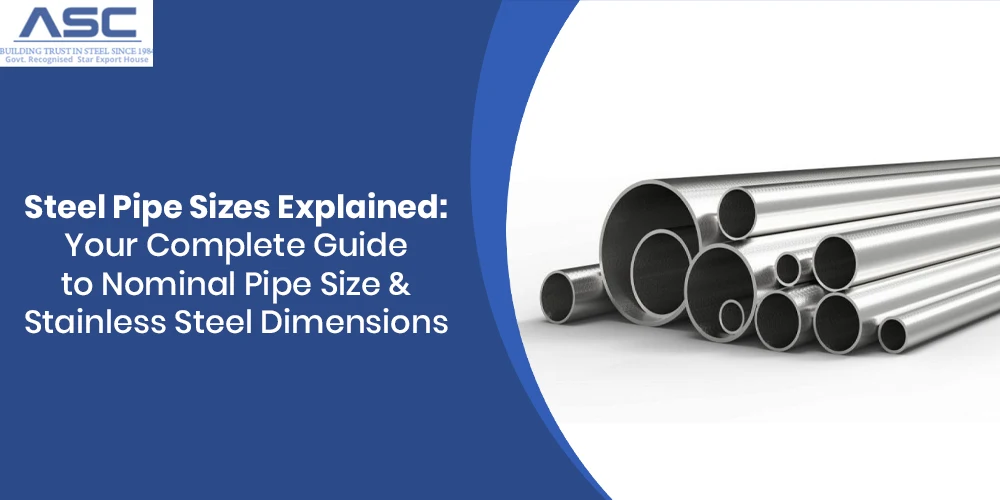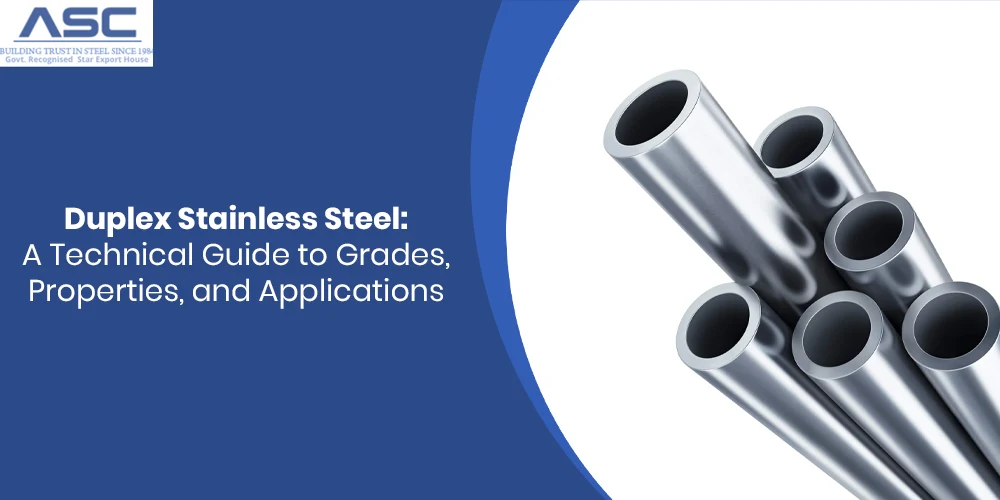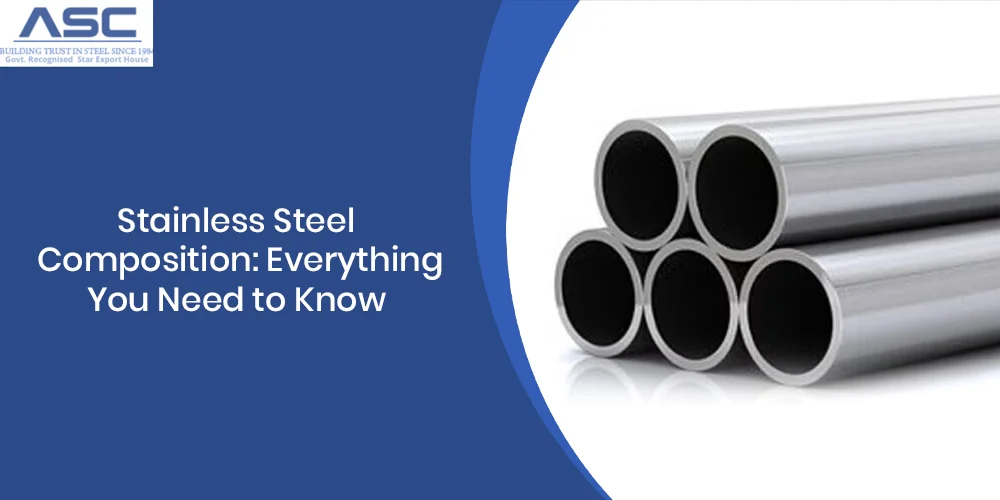Steel Pipe Sizes Explained: Your Complete Guide to Nominal Pipe Size & Stainless Steel Dimensions
by AMC
Posted on May 05, 2025 at 05:01 PM

Dealing with steel pipe sizes? If you're nodding, you know it can feel like a puzzle, especially when your project demands precision for industrial work, construction, or specialized engineering. Here’s the unvarnished truth: get the pipe dimensions wrong at the start, and you're inviting problems. Think installation headaches, performance drops, even safety issues. At Amardeep Steel Centre, these details are our bread and butter. We see firsthand why total clarity on stainless steel pipe sizes and the often-puzzling Nominal Pipe Size (NPS) is non-negotiable. This guide is built to give you that clarity, so you can specify and order exactly what your project needs, with no second-guessing. We want to make choosing the right steel pipe a simpler task
The Critical Importance of Accurate Steel Pipe Sizes
Why all the fuss about getting steel pipe sizes exactly right? It’s not just about parts fitting snugly. The dimensions you choose send ripples through your entire project:
- How much can it move? The pipe's internal diameter directly controls flow rates. For any system moving fluids or gases, this isn't a small detail; it's fundamental.
- Can it handle the strain? Wall thickness, paired with the steel's inherent strength, dictates its pressure-holding capacity. This is a safety-critical point.
- Will it stand firm? Sometimes pipes do more than carry contents; they support loads. In these cases, their dimensions are vital for structural integrity.
- Does it connect smoothly? Your pipes must integrate perfectly with every fitting, valve, and component. "Almost right" isn't an option.
- What's the cost of an error? Using incorrect steel pipe sizes inevitably leads to wasted materials, frustrating delays, and escalating project expenses.
So, becoming familiar with terms like Nominal Pipe Size, outside diameter (OD), inside diameter (ID), and pipe schedule isn't just academic – it's your first practical step to sound specifications.
Understanding Nominal Pipe Size (NPS): What It Means for Steel Pipes
If your work involves pipes made to North American standards, "NPS" is a term you'll see constantly. But what is Nominal Pipe Size in practice? NPS, or Nominal Pipe Size, is the standard North American way of classifying pipes used across a wide spectrum of pressures and temperatures. It’s a key label. Yet, it's vital you understand what Nominal Pipe Size means because it doesn’t always directly match the pipe's actual, measurable dimensions.
Here’s a common point that can cause confusion: the Nominal Pipe Size number isn't always the same as the pipe's actual outside diameter (OD). This is particularly true for smaller diameter pipes:
- Take pipes from NPS 1/8 through NPS 12: Here, the NPS number is more of a category name. The actual OD will always be larger than this NPS number suggests. An NPS 12 pipe, for instance, actually measures 12.75 inches on the outside.
- Now, for NPS 14 and larger pipes: Things simplify. The NPS number does directly tell you the OD in inches. So, an NPS 14 pipe really is 14 inches across its outside.
This difference has historical roots. The original NPS system aimed for consistent inside diameters for certain wall thicknesses. As manufacturing advanced and more wall thicknesses (what we call pipe schedules) became standard, the NPS label stuck, but its direct dimensional link changed, especially for those smaller pipes.
To sidestep any errors, your most reliable companion is always a Nominal Pipe Size chart (often called an NPS pipe chart). These charts clearly list each NPS, its true OD, and the wall thicknesses for the various schedules.
Pipe Schedule & Wall Thickness: Key to Steel Pipe Strength & Capacity
While Nominal Pipe Size gives you a general category, it doesn’t tell you about the pipe wall's actual thickness. For that crucial piece of information, you need to look at the "pipe schedule" (you'll see it abbreviated as SCH or Sched.). The schedule number provides an indication of a pipe's approximate wall thickness.
Grasping these points about pipe schedules is key
- Consider two pipes of the same Nominal Pipe Size. The one with the higher schedule number will have a thicker wall. This means an NPS 2 Sch 80 pipe has a more robust wall (and thus a smaller internal opening for flow) than an NPS 2 Sch 40 pipe.
- Importantly, the actual wall thickness for a specific schedule changes depending on the Nominal Pipe Size. So, the Sch 40 wall thickness for an NPS 1 pipe is different from the Sch 40 wall thickness for an NPS 6 pipe.
- You'll frequently see schedules like Sch 5 through 160, plus Standard (STD), Extra Strong (XS), and Double Extra Strong (XXS). It’s useful to remember that for many common sizes, Sch 40 is the same as STD, and Sch 80 matches XS.
The Nominal Pipe Size, OD, and schedule are interconnected; together they define the inside diameter (ID). The ID is absolutely critical for any calculations related to flow (ID = OD - 2 x Wall Thickness). You'll find that a Nominal Bore Pipe Size Chart or a detailed NPS pipe chart lists these IDs, ensuring you can select pipes with the right capacity and pressure rating for your job.
OD vs NPS: Demystifying Outside Diameter and Nominal Pipe Size
The difference between Outside Diameter (OD) and Nominal Pipe Size (NPS) is important to get right:
- NPS is a standard label for a pipe size category.
- OD is the actual physical measurement of the pipe's exterior.
When thinking about OD vs NPS, this is the core distinction:
- For pipes NPS 12 and smaller: The NPS number and the OD are not the same (the OD is always larger).
- For pipes NPS 14 and larger: The NPS number equals the OD (in inches).
Always, always verify the actual OD from a reliable Nominal Pipe Size chart when writing specifications, especially if the application is critical or involves matching existing pipework.
Exploring Steel Pipe Sizes & Stainless Steel Pipe Sizes in Detail
While the NPS system is broadly applied, materials like carbon steel and stainless steel each have their own specific points to consider. You'll find steel pipe sizes used everywhere – from building structures and oil/gas lines to manufacturing plants. Stainless steel pipe sizes, on the other hand, are chosen for their excellent corrosion resistance, making them indispensable in food processing, pharmaceuticals, and chemical industries.
Understanding Standard Steel Pipe Sizes in India
If you're working on projects in India, a solid grasp of standard steel pipe sizes in India is essential. International standards (like ASME B36.10M for carbon/alloy steel, and B36.19M for stainless) are widely used, but Indian Standards (IS) also play a key role. It's common to see sizes specified using both NPS/Schedule and their metric counterparts (DN/mm). At Amardeep Steel Centre, we can help you navigate and cross-reference these to ensure you get the precise steel pipe sizes you need.
A Closer Look at Stainless Steel Pipe Sizes & Schedules
Stainless steel pipe sizes generally adhere to the NPS/schedule system. However, ASME B36.19M, a standard specifically for stainless steel, introduces "S" suffix schedules (like Sch 10S, Sch 40S). These "S" schedules often indicate thinner walls compared to non-S versions, especially in larger diameters. Why? Stainless steel's higher strength allows for lighter designs in certain applications. You'll find a vast range of stainless steel pipe sizes, with popular grades like 304L and 316L widely available.
Converting Stainless Steel Pipe Sizes to mm: A Practical Approach
For metric-driven projects or smoother international work, stainless steel pipe sizes in mm are common. This usually means specifying the OD and wall thickness (WT) in millimeters. The metric counterpart to NPS is DN (Diameter Nominal); for example, NPS 1 is roughly DN 25. Accurate conversion charts are vital here, as the NPS-to-metric relationship isn't always a simple calculation due to the NPS system's history. A good Nominal Pipe Size chart will typically include DN equivalents and OD/WT in mm.
Steel Square Pipe Sizes & Stainless Steel Square Pipe Sizes: Beyond Round
It's not all about round pipes. Square hollow sections (SHS), or square pipes, are also heavily used, particularly in structures and architectural designs. Steel square pipe sizes and stainless steel square pipe sizes are defined by their outside dimensions (e.g., 50mm x 50mm) and their wall thickness. Unlike round pipes, their sizing is more direct. When specifying steel square pipe sizes or stainless steel square pipe sizes, you simply state the side lengths and the wall thickness. A good selection of both stainless steel square pipe sizes and steel square pipe sizes is generally available.
How to Effectively Use a Nominal Pipe Size Chart (NPS Pipe Chart)
A Nominal Pipe Size chart (or NPS pipe chart, Nominal Bore Pipe Size Chart) is a non-negotiable tool if you're specifying pipes. Think of it as your essential map. To use one well:
- Know Your NPS: Start with the Nominal Pipe Size your project specifies.
- Find the Actual OD: Look up the corresponding actual Outside Diameter on the chart.
- Select Schedule/Wall Thickness: Based on pressures, corrosion concerns, and structural needs, choose the right schedule or specify an exact wall thickness. The chart will link these to your NPS.
- Note the ID/Nominal Bore: The chart should also give you the inside diameter – absolutely vital for flow calculations.
- Check Pipe Weight: Many charts include weight per unit length. This is useful for load calculations and estimating shipping.
- Look for Standards: Good charts often reference the manufacturing standards they adhere to (e.g., ASME B36.10M).
- Units Matter: Always be clear if you're working in inches or millimeters.
Whether you're dealing with common carbon steel pipe sizes or need specifics for stainless steel pipe sizes in mm, a reliable chart is your best friend.
Essential Details for Ordering Your Steel Pipe Sizes Correctly
To ensure you receive exactly the steel pipe sizes or stainless steel pipe sizes you need, clear and complete information for suppliers like Amardeep Steel Centre is paramount. Typically, this means providing:
- Nominal Pipe Size (NPS): (e.g., NPS 6).
- Pipe Schedule or Specific Wall Thickness: (e.g., Sch 80, or a precise thickness like 0.375 inches).
- Material Grade: (e.g., ASTM A106 Grade B for carbon steel, ASTM A312 TP316L for stainless).
- Pipe End Type: (e.g., Plain End - PE, Beveled End - BE).
- Required Length(s): (Standard mill lengths or custom cuts).
- Quantity: (Number of lengths or total meterage).
- Any Applicable Standards or Special Requirements.
For steel square pipe sizes or stainless steel square pipe sizes:
- Outside Dimensions: (e.g., 75mm x 75mm).
- Wall Thickness: (e.g., 4mm).
- Material Grade, Length, and Quantity.
Clear communication prevents costly mistakes. If you're ever unsure about what is Nominal Pipe Size for your application, or how to interpret an NPS pipe chart, don't hesitate to consult with experienced suppliers.
Amardeep Steel Centre: Your Partner for All Steel Pipe Sizes & Needs
A solid understanding of steel pipe sizes, including the details of Nominal Pipe Size, pipe schedules, and specific stainless steel pipe sizes, is fundamental to the success of any project involving piping or structural steel. Whether your work involves small-bore stainless steel pipe sizes in mm for precise process lines or large-diameter carbon steel pipe sizes for major infrastructure, getting the dimensions right is non-negotiable.
At Amardeep Steel Centre, we aim to provide solutions, not just sell pipes. We are committed to supplying top-quality steel and stainless steel pipes across a truly comprehensive range of sizes and specifications. Our inventory also includes a diverse selection of steel square pipe sizes and stainless steel square pipe sizes. Our team’s expertise means we can help you confidently navigate the sometimes-complex world of pipe dimensions – from clarifying a Nominal Pipe Size chart to ensuring your specifications align with standard steel pipe sizes in India. Our goal is to assist you in selecting the optimal steel pipes for your application, ensuring both superior performance and genuine value.
When you are ready to discuss your steel pipe requirements, please contact Amardeep Steel Centre. Allow our industry knowledge and extensive stock to contribute to your project's success. We look forward to the opportunity to assist you.

Duplex Stainless Steel: A Technical Guide to Grades, Properties, and Applications
Navigating material selection for demanding environments often leads engineers to consider advanced options. Duplex stainless steel, with its unique microstructure and balanced

